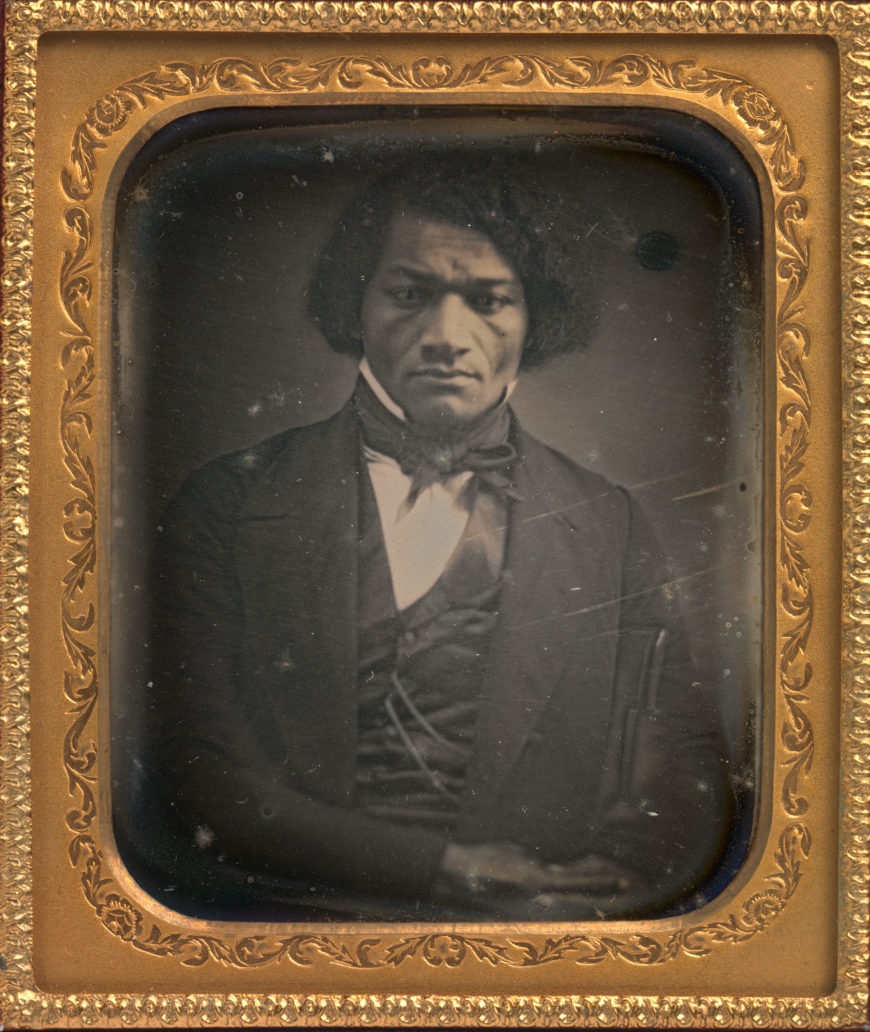
Frederick Douglass, c. 1850, photograph, 6.6 x 5.3 cm (National Portrait Gallery, Smithsonian Institution)
It is evident that the great cheapness and universality of pictures must exert a powerful, though silent, influence upon the ideas and sentiment of present and future generations.Frederick Douglass, Lecture on Pictures, Boston (December 3, 1861) [1]
Images played a central role in the debates over slavery and Black citizenship that consumed the United States in the years leading up to the Civil War. For example, Frederick Douglass, the great abolitionist, writer, publisher, and thinker, who escaped from slavery as a young man, was an ardent admirer of Louis Daguerre, the inventor of the daguerreotype, an early form of photography. Douglass celebrated photography as a democratic art, and he saw portraits as a tool in the battle for abolition and citizenship, at a time when popular, widely circulated images depicted racist stereotypes of Black people. During his travels, he sought out photographic studios, and sat for numerous photographs over decades, always consciously attired in the clothes of a gentleman. This was part of his effort to represent himself, especially his self-possession, dignity, and character—his full humanity, and therefore by extension, the humanity and rights of all Black people to freedom and citizenship. Through this project, Douglass became the most photographed man of the 19th century. [2]
Art is always a register of the historical era in which it was made. It expresses, consciously or not, the concerns, prejudices, and assumptions of its cultural moment. In an era when cultural assumptions were at loggerheads, images can reveal, sometimes in stark relief, the clash of ideas and ideologies.
For example, when we consider images of slavery, we are usually looking at either images that sought to rally sympathy for enslaved people and motivate political advocacy for change, or we are looking at imagery that softened the brutal reality of slavery to make it appear as a beneficial institution for all. Much as we would like an objective window into the past, there are no neutral images that can tell us about the realities of life as an enslaved person. All images, including drawings and even photographs, require contextualization.
We have to ask, who took the photograph or picked up the paint brush? What was their motive? What can the image itself tell us about the point of view of its creator? Where was the image circulated? Who was its intended audience? What is the relationship of the image to other images of the same subject?
Two photographs
Let’s begin with two photographs of Black men taken in the 1850s, not long after photography’s invention. Photography was celebrated for its astonishing ability to accurately portray the world, but in the images here we see the ways that photography could be used to further both pro- and anti-slavery positions.

Left: Frederick Douglass, c. 1855, daguerreotype, 8.3 x 7 cm (Metropolitan Museum of Art); right: Joseph T. Zealy, daguerreotype of Renty Taylor, 1850 (Peabody Museum of Archaeology and Ethnology, Harvard University; photo: Unibond)
On the left is another portrait of Douglass wearing an impeccable suit, as he turns to present a three-quarter profile and looks directly at the viewer with a confident, even challenging expression. The other, an older man, is stripped to the waist, his sinews and scars suggest a long life of labor. He too is looking directly at the viewer, but his expression is harder to read: resigned, defiant, entreating?
Despite the similarities in media, subject, and era, the circumstances and purpose of these photographs could not be more different. On the right is Renty Taylor, an enslaved man who was born in central Africa in the late 18th century. He posed for the photograph not of his own volition but at the direction of Harvard biologist Louis Agassiz.
Agassiz was a Harvard professor and regent of the Smithsonian Institution and helped to found the National Academy of Science. He was a naturalist, but also an opponent of Charles Darwin’s theory of evolution. Agassiz turned to photography to support the racist pseudo-scientific theory of polygenesis, which posited that the races had separate origins, and therefore racial difference—both white supremacy and Black inferiority—were immutable scientific facts. [3]
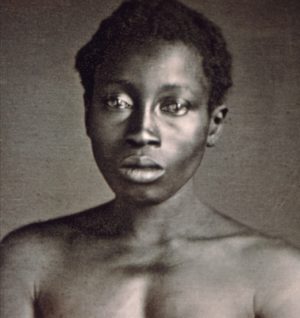
Joseph T. Zealy, daguerreotype of Delia Taylor (cropped), 1850 (Peabody Museum of Archaeology and Ethnology, Harvard University; photo: Hannolans)
Agassiz commissioned daguerreotypes of enslaved men and women and their adult children living in South Carolina, believing that the photographs would demonstrate Black people had innate physical differences. Delia, who was Renty Taylor’s daughter, was also forced to pose, stripped to the waist, for a daguerreotype taken by Joseph T. Zealy. As an enslaved Black woman, Delia was not afforded the protection of modesty that white women of her era could command. Agassiz also had Renty Taylor and numerous other Black men and women photographed nude.
Agassiz used his interpretation of their physical features to argue (incorrectly) that Black people had been created separately from whites. As Douglass used photography as a tool to humanize Black people born into slavery, Agassiz used the camera as a weapon to dehumanize his subjects, reducing human beings to specimens.
In the end, Agassiz’s photographs are not evidence of the inferiority of one race in comparison to another, but of the brutality of white supremacy and slavery, and the physical harm and humiliation it caused. The photographs of Delia and Renty document people exposed against their will, but also represent the many millions whose identities have been lost to history, who were bought and sold and who labored so that their white owners might prosper.
Promoting abolition
In the North, free Black people, including Douglass, formed a vital part of the abolitionist movement. Along with white abolitionists, they were active in raising money and helping enslaved people escape to free territory. They published narratives of their experiences in slavery and freedom, printed abolitionist newspapers, and lectured to audiences in the Canada, United States, and Europe.
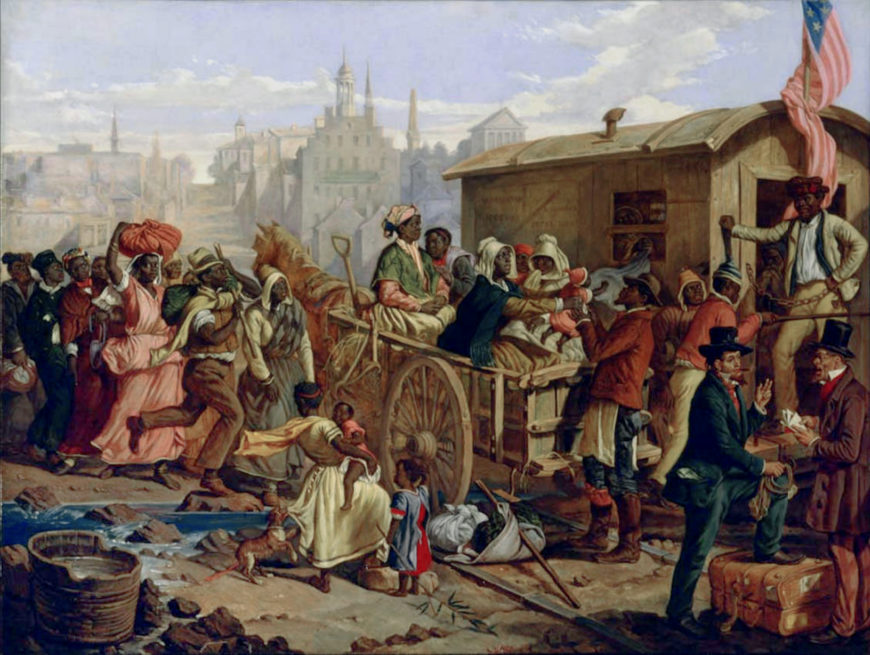
Eyre Crowe, After the Sale: Slaves Going South from Richmond, 1853, oil on canvas, 27 x 36 inches (Chicago History Museum)
Many of the images produced to support abolition, however, were created by white artists. Take, for example, the 1853 painting by the British artist Eyre Crowe entitled After the Sale: Slaves Going South from Richmond, which was exhibited in London in 1854. Crowe was inspired to learn more about slavery in the United States after reading Uncle Tom’s Cabin (the best-selling antislavery novel by Harriet Beecher Stowe). Crowe made several paintings of this subject, all based on sketches made from life at Shockoe Bottom, in Richmond, Virginia. It was at Shockoe Bottom where enslavers bought and sold men, women, and children, forcibly separated families, and procured slave labor for whites across the American South. Crowe was clearly sympathetic to the abolitionist cause, and intended to use the painting (and others he made on the subject) to expose the brutality of slavery. He also wanted his paintings to be well received when exhibited.
Crowe’s painting is full of specific details that seek to convince the viewer of the authenticity of what we’re seeing. We see the Richmond skyline in the distance. Just beside the top of the train car we can see the state capitol building designed by Thomas Jefferson in the style of an ancient Greek temple—a reference to the origins of democracy and ideals of justice and equality. Below can be seen a rocky creek in the foreground, a railway car clearly labeled with its destination, a dog nipping at a girl, and sacks of clothing on the ground. At the far left, enslaved people are marched in—likely from a jail where they were kept after being sold, and are headed toward the railway car. On the far right, we see two disreputable white figures engaged in a transaction that we assume has something to do with the enslaved figures. Above them, a Black man (perhaps enslaved to the railroad), holds a chain and an open lock in front of the doorway leading into the train car. An American flag flutters behind and above him.
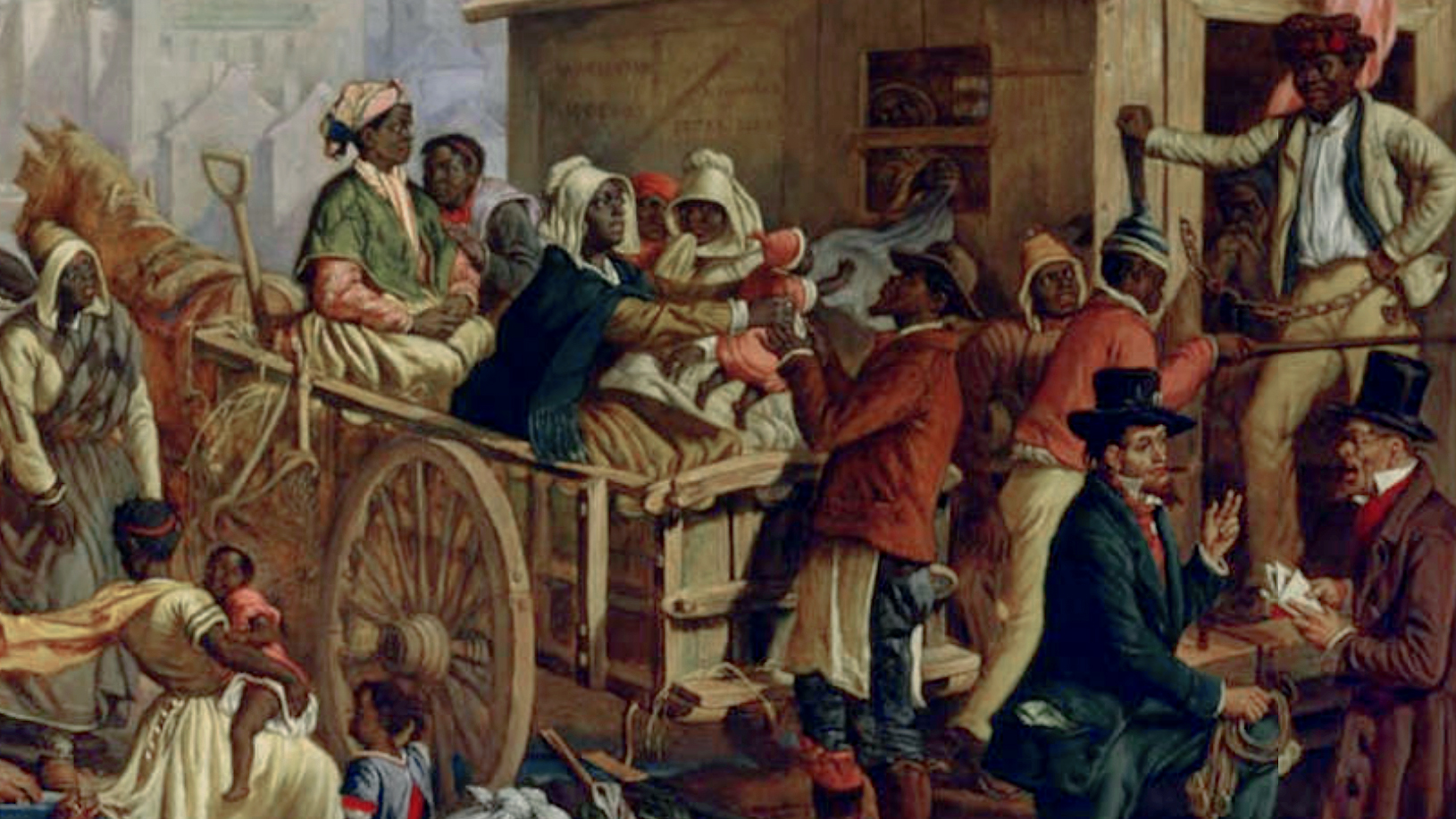
Eyre Crowe, After the Sale: Slaves Going South from Richmond (detail), 1853, oil on canvas, 27 x 36 inches (Chicago History Museum)
The most important action though, takes place in the center, where we see a young woman in a wagon handing a child (hers, we assume), to a man. We presume this family is being torn apart because the woman has been sold. Another woman in a white cap located behind and between the mother and child seems to gasp and hold her hand to her mouth. In the center foreground a dog nips at the skirt of a woman holding a baby, recalling how those who escaped from slavery were often pursued by bloodhounds. Taken together with the state capitol building in the distance, we can see that Crowe has carefully crafted his painting to underscore the great distance between the ideal of democracy and the abomination of American slavery.
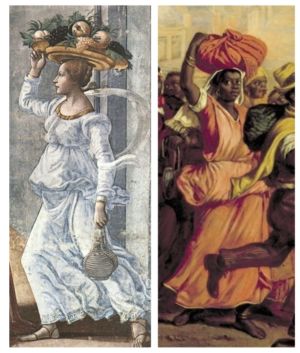
Left: Domenico Ghirlandaio, Birth of St. John the Baptist (detail), 1486–90, fresco, Santa Maria Novella, Florence; Right: Eyre Crowe, After the Sale: Slaves Going South from Richmond (detail), 1853, oil on canvas, 27 x 36 inches (Chicago History Museum)
Crowe described the “sense of horror” he felt when he visited the slave market, and yet, as cultural historian Maurie D. McInnis has pointed out, this image, and others Crowe made of slavery, hardly seem that brutal at all. [4] The figures exchange meaningful glances (for example, the upright figure in the carriage and the man holding chains), but their expressions do not match the emotional turmoil of the scene.
The artist used a number of pictorial strategies to make the work palatable for viewers, including drawing on the history of art. [5] Take for instance the woman in the orange dress striding forward who looks out (perhaps to implicate us?) carrying a basket on her head. Her graceful stance and the way her dress moves even as it clings to her body looks back to Italian Renaissance art.
Defending slavery
At a time of dire poverty for many workers (both Black and white), slavery’s defenders argued (untruthfully) that slavery was a superior system, where owners cared for enslaved people from birth until death, whereas factory owners abandoned white laborers the moment they could no longer work. An 1841 lithograph by Edward Williams Clay (a northern artist who created many prints advocating for white supremacy) contrasted the “happy” slaves of the American South with the abused wage laborers of English factories. Clay’s print includes stereotypical images that would have been familiar to popular audiences.
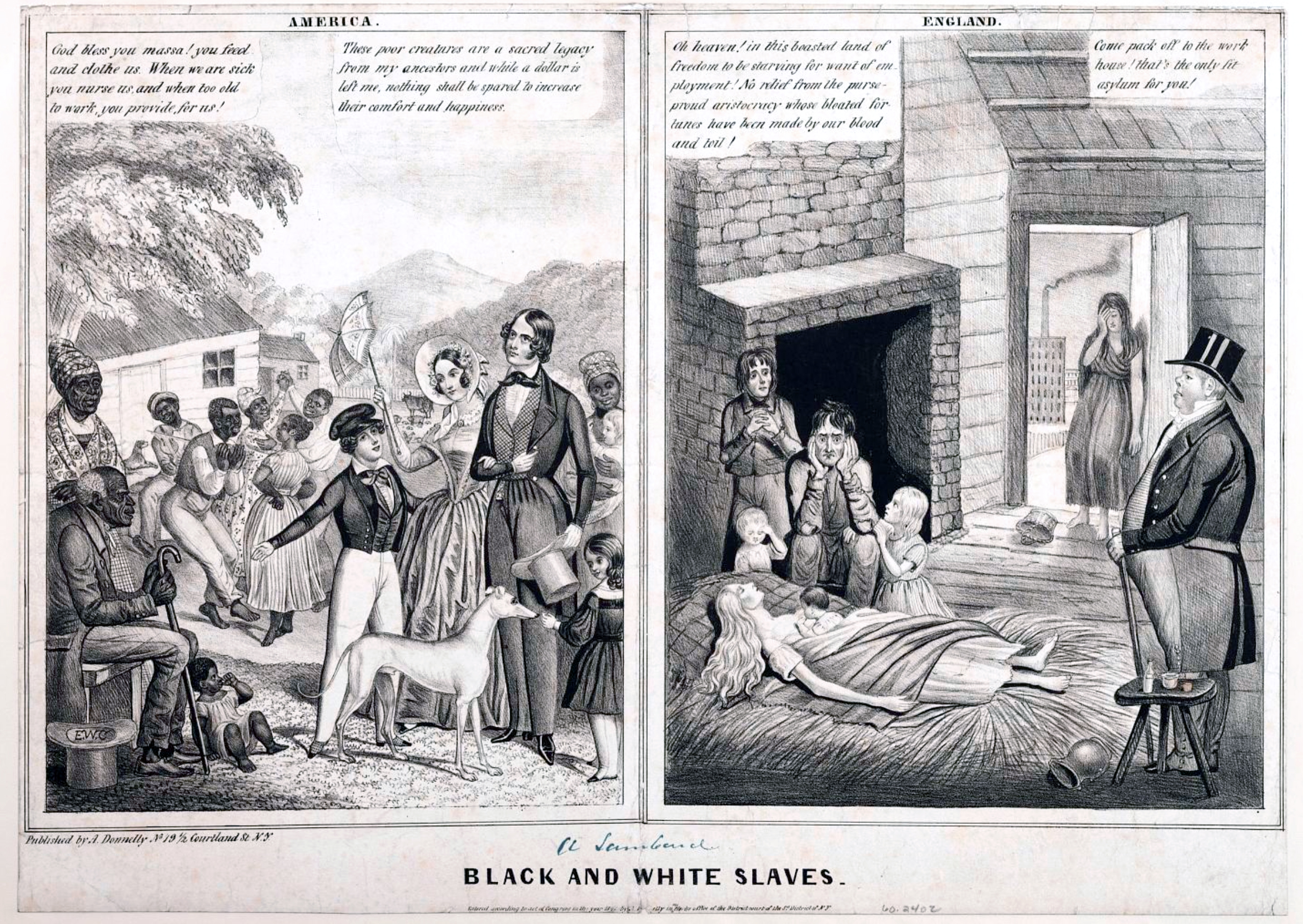
This cartoon contrasts the “happy, well cared-for” enslaved Black people of the American South with the “wage slaves” of England’s factories. Edward Williams Clay, America (Black and White Slaves), c. 1841, lithograph published by A. Donnelly, 31.43 x 48.26 cm (Smithsonian National Museum of American History)
On the left, Clay offers the slave quarters on a plantation with dancing Black figures. In the foreground, the enslaved of all ages appear content and well cared for by a young, fashionably dressed white family. The captions are even less subtle. Here, the enslaved are given the degrading words, “God bless you massa! You feed and clothe us.” The white man calls the Black family “poor creatures” and vows to “spare nothing to increase their comfort and happiness.” The image underscores the paternalistic premise that white owners generously provided for the enslaved (the way a father cares for his children).
In opposition, the image on the right depicts figures distinguished by economic and social class rather than race. A white mother lays dying as her family mourns and a wealthy landowner evicts them from their home. In the distance, a factory emits smoke from its chimney. While the two images purport to contrast a harmonious view of southern plantation life with destructive industrialization in Britain, many viewers would have understood that it also referenced the abuses of the more industrialized economy of the northern United States. Clay’s lesson is clear: the southern way of life (the enslavement of Black people) is moral and just and superior to the barbarous inhumanity of industrialization.
Images at the forefront
Images were at the forefront of arguments for and against slavery in the 19th century and helped to inform contemporary opinions about slavery and the status of Black people in the United States. The new medium of photography was an especially potent weapon in this debate—employed both by abolitionists to counter racist stereotypes of Black people and by white supremacists in support of slavery. But photography’s “truth” was no more objective than the scenes conjured in paintings and prints: all such images were ammunition in a larger battle over the future of the nation.
Notes:
[1] Opening Douglass quote from his “Lecture on Pictures” (also called “Pictures and Progress”) in Boston’s Tremont Temple, 1861. See also John Stauffer, Zoe Trodd, and Celeste-Marie Bernier, Picturing Frederick Douglass: An Illustrated Biography of the Nineteenth Century’s Most Photographed American (New York: W. W. Norton & Company, 2015).
[2] See John Stauffer, Zoe Trodd, and Celeste-Marie Bernier, Picturing Frederick Douglass: An Illustrated Biography of the Nineteenth Century’s Most Photographed American (New York and London: W.W. Norton & Company, 2015).
[3] Douglass addressed this pseudoscience in “The claims of the Negro, ethnologically considered: an address before the literary societies of Western Reserve College,” at commencement, July 12, 1854.
[4] Eyre Crowe, “Sketches in the Free and Slave States of America,” The Illustrated London News, September 27, 1856, p. 314.
[5] For a full discussion, see Maurie D. McInnis, Slaves Waiting for Sale, Abolitionist Art and the American Slave Trade (Chicago: University of Chicago Press, 2011), chapter 6.
Additional resources
Ilisa Barbash, Molly Rogers, and Deborah Willis, eds., To Make Their Own Way in the World: The Enduring Legacy of the Zealy Daguerreotypes (New Haven and Reading, Pennsylvania: Peabody Museum Press and Aperture Press, 2020).
Maurice O. Wallace and Shawn Michelle Smith, eds., Pictures and Progress: Early Photography and the Making of African American Identity (Durham: Duke University Press, 2012).
John Stauffer et. al., Picturing Frederick Douglass: An Illustrated Biography of the Nineteenth Century’s Most Photographed American (New York: Liveright Publishing Corporation, 2015).
Learn more about Eyre Crowe’s images of the slave trade at Encyclopedia Virginia.


